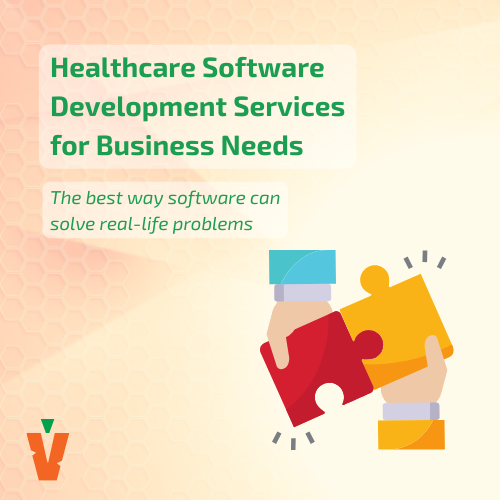You know your coding, PM methodologies, and QA strategies for producing quality, reliable health tech. But do you know healthcare software marketing? Because without it, nobody will use the product or service your company meticulously crafted.
Marketing is something we rarely discuss in the world of healthcare software technology, but I believe this should change ASAP. Not only does marketing help your company, but the right messaging can also increase tech adoption rates and improve patient outcomes. That’s why I’m here to dive into everything your healthcare marketing strategy needs to succeed.
Before I became the Director of Marketing at Vitamin Software, I worked in various marketing agencies, much of my work surrounding the startup landscape for medical devices, healthcare insurance companies, and data management firms. It’s safe to say that I bring a different perspective from your typical healthcare decision-maker.
Since it’s launch season, let’s put marketing matters into that perspective and see what you need to do to successfully release healthcare software. I’ll break it down into steps, discussing the basics and sharing specific tips I’ve gathered during my years in the industry.
Step 0: Establishing Compliance Guidelines
Marketers are good at navigating the limitations of Google’s ever-improving algorithm, but even then, the strictness of the healthcare industry sometimes catches us off-guard. A simple brand guideline won’t cut it — you want it to, first and foremost, be a legal compliance protocol.
Of course, the guidelines should include brand voice, style, and messaging, but only on top of a firm regulatory foundation. Here are the basics:
- Truthfulness and transparency. All marketing materials must communicate the software’s capabilities and limitations. You can’t make any exaggerated claims about functionalities or benefits.
- Substantiated claims. Back every statement with solid evidence, like expert reviews, user testimonials, or clinical studies in the case of medical software. If you can’t find evidence, don’t say it — or clarify that you’re speculating.
- Disclosure of risks. Clearly state the potential risks or limitations of your product or service. Healthcare software marketing isn’t as strict as advertising meds or therapies, but it’s better to err on the side of caution.
To learn more, visit the HHS privacy guidance for marketing and check out this helpful guide on healthcare advertising compliance.
Even if you have prior healthcare experience, involve an attorney in guideline creation. The joint skills of legal and marketing professionals ensure your strategy is compliant and effective.
Involve Marketing In Early Conversations
Writing a good healthcare software marketing plan requires an early start — as soon as the software passes the viability check, or better yet, during the planning phase. That way, as you determine functionalities, you’re also considering ways to position yourself on the market.
Software engineers aren’t often the best salespeople, and their ideas rarely resonate with the general public (or executives). Involving marketers means that, as you determine functionalities, you’re also considering ways to position yourself on the market.
I wish more software companies included marketers in early conversations surrounding product features, future users, and project timelines. We usually get involved late, get messy data, and must get to market as soon as possible. And the results show it.
Step 1: Determining Targets & Desired Outcomes
You’re working with an experienced marketer if they have a clear rationale for every strategy decision they make. And that starts long before writing blogs or measuring click-through rates. Expect them to shadow you in early meetings and interview folks left, right, and center to get a picture of your company’s position and the project’s purpose.
The objectives of a healthcare marketing strategy should align with the overall business goals. During a launch, you might want to penetrate a market or gain a larger share — whatever it is, the marketing plan lies on top of that goal.
Next, to put things into context, analyze the competitive landscape, market demand, and customers’ pain points. These data points build a strategy that lets you produce desirable software and position it competitively.
Start By Understanding Yourself (As a Company)
The first thing you want to do is a SWOT analysis. You want to start a marketing campaign with knowledge of all four elements — strengths, weaknesses, opportunities, and treats — and enough time to find ways to exploit them. Every resource can be an advantage in ads or sales, and each weakness must be accounted for before you begin external communications.
Companies often overlook their strengths, like senior, well-connected employees who could expand the marketing pool for early-stage testing. They hyperfocus on what they lack, which delays the launch and causes long-term issues.
Opportunities point to ways you can grow within the market or develop your service to be more efficient, user-friendly, valuable, suitable to international markets, you name it. Your marketers can lay the groundwork for these prospects.
Threats are often operational, so confirm that your marketing team understands your limitations as a business. Overpromising is shooting yourself in the foot because it makes clients expect more than you can deliver. And a bad customer experience is a sure way to lose a prospect.
In healthcare, buyers don’t care about fancy, flashy outcomes but want a secure, reliable, simple solution. If you can make their lives easier in a better way than their competition, you’re on the right path.
Step 2: Defining the Brand Story & USP
Did you know that even in B2B healthcare technology, a good story can make or break a sale? You’re still advertising to humans whose brains recognize tropes and love a good narrative. So, the next step is all about storytelling.
Once you know where you stand on the market, concretize your position into a brand story and unique selling proposition (USP). Craft narrative and value statements that resonate with your target audience, and then tweak all external communications to match them.
The brand story encapsulates your company’s origin, mission, values, and the journey that led to your healthcare software. For instance, share a personal experience when you struggled with inefficiencies in a hospital that inspired you to create tech that simplifies patient management.
Remember: Storytelling for healthcare brands is usually about people and purpose. For instance, look at the description of branding for a community hospital:
For Arnot Health, their brand’s story was closely tied to the community since they are a community hospital, serving friends and neighbors for over 150 years. In their rebrand spot, we featured the faces of the unsung local heroes who make their town special – before bringing it into the hospital setting.
The USP sets your software apart from competitors. It might focus on superior features, exceptional customer support, solutions tailored to specific healthcare settings, or a track record of improving patient outcomes. For Vitamin, it’s reliability: being on time and budget.
Despite its more concrete nature, the USP can be catchy and enticing. Consider The Doctor’s Crossing and its unique proposition — Figuring out if medicine is still for you just got a whole lot easier. It’s simple, straightforward, and irresistible for just the right audience.
Your healthcare marketing strategy should also determine whether you’re in a blue or red ocean.
A red ocean is a competitive space (imagine it so full of sharks that the water is tinted red from their attacks) where you compete for a share of the demand. In such environments, marketing should demonstrate why your software offers the best value.
A blue ocean strategy involves creating a new market space (entering clear waters). In this scenario, emphasize the pioneering aspects of your solution, backed by testimonials, case studies, and data demonstrating its effectiveness. Explain and awaken the need, and you become a thought leader.
Focus On Tangible Benefits
One of the most notable marketing campaigns ever is Domino’s ‘We deliver in 30 minutes, or you don’t have to pay.’ It’s short, simple, and irresistible. Does Domino’s have the best pizza in the world? No, but their business model doesn’t revolve around it. It’s similar across industries — you don’t have to be the best but must reliably deliver what you promised.
Tie the brand story to hero moments — imagine a big issue and an individual facing it and overcoming it, coming out stronger because they have a mission. In practical terms, describe how you solve a specific problem in a particular market.
We should also mention the unique value offer, which differs from the USP. The latter is about the customer, while the former is about you — an intrinsic value unique to your business.
Once you have a UVO, USP, and brand story, the grounds for a healthcare marketing strategy are covered.
To give you an example of what it might look like in the healthcare space, check the genius marketing identity of Dr. Reddy’s Laboratories. We accelerate access to affordable and innovative medicines because Good Health Can’t Wait. Everything else, from the brand story to specific pursuits, builds on this resounding idea.
Step 3: Setting Goals & Timelines
The next step is hands-on goal-setting for your healthcare software marketing campaign. SMART goals are the best way to go about it — specific, measurable, achievable, realistic, and time-bound marketing activities and objectives. Put them on a timeline with milestones, and you’re good to go.
In the context of a software launch, goals typically relate to awareness or sales. Yours could be to close with a large vendor or attract many patients, payers, or providers. It depends on the size of your company, the software you're building, and your addressable market. An example: Generate 50 qualified leads from the pool of healthcare providers within the next quarter through email campaigns and webinar registrations.
Don’t Do Marketing in a Silos
For one, the marketing team needs to know the business objective. The leadership and board of directors tell us what the company wants to achieve in a year and three years. I find five-year marketing goals unrealistic, but three-year ones are suitable if we adjust them yearly.
Then, learn about all touchpoints where we represent ourselves to create a branded approach. Every step of the customer journey should match your brand mission, vision, style, and substance.
The development team could integrate marketing activities, like promos or feedback collection, into the platform. Compliance information comes from the legal team, while cybersecurity guidelines are on security.
Client success should track the user experience and allow the marketing team space to delight the customers. If we’re selling B2B, we support sales with collateral that offers incentives, like PDFs, guidebooks, and events.
In a nutshell, healthcare software marketing should be intertwined with every other team. That is how you distinguish a bland solution from an incredible company full of personality.
Step 4: Finalizing the Go-To-Market Strategy
The go-to-market (GTM) strategy for a healthcare software launch involves picking awareness tactics, communication channels, and buyer personas. It differs based on who you’re targeting, with buzz for broad audiences and account-based marketing (ABM) for deals with high-value prospects.
The former uses mass media channels, viral content, and word-of-mouth to generate excitement around your healthcare software. It’s suitable for building brand recognition and reaching a broad network.
ABM targets decision-makers within healthcare organizations. It involves personalized outreach, tailored content, and one-to-one engagement to address their unique needs. This option is ideal for reaching high-value prospects and targeted conversions.
.png?width=379&height=674&name=GTM%20steps%20(2).png)
Prioritize Value for Your Target Audience
During the launch, marketing activities should support executives and salespeople while they network with potential customers. And to do that, we can’t rely on the shiny, mass-produced, SEO-optimized tactic without substance.
I notice one key difference between salespeople who connect with executives and those who fail. The second group believes that money makes the world go around, while the second knows that money follows value.
As a mindset, find ways to provide value to your prospects at each touchpoint. It can come from an inbound attitude or an unexpected strength (like a well-connected team member). Either way, no communication with a buyer should transpire without a value offer.
Since the marketing budget is limited (even though it should be 30% of yearly revenue, in my opinion), it matters to choose your battles. Pick tactics you think will bring you the closest to target outcomes. You might miss, or sometimes, your least favorite campaign will create the most traction. That is fine. You are not your buyer persona. Track leading indicators and add more resources where you see performance. Don’t take the misses close to heart, but use them as a learning opportunity.
Step 5: Measuring & Optimizing Performance
You can’t launch a healthcare software marketing campaign and sit back with your fingers crossed. To get the best results, you must measure its performance. Key metrics include site traffic, conversion rates, customer acquisition costs, retention rates, and return on investment. These KPIs will help you optimize resource allocation and outcomes.
.png?width=400&height=220&name=Pro%20tip%20VS%20(6).png)
How do you measure these? With the use of analytics and benchmarking. Establish baseline metrics to gauge performance against industry standards or historical data. Monitor your progress and adjust goals based on outcomes. If you’re constantly overshooting, you might need to dial down, and if you’re doing better than expected, it’s time to raise the bar.
Plan for Impact Next Year
Despite what many people believe, marketing doesn’t yield immediate results. You’re playing a long game where the return on current investment becomes visible months into the future.
For SEO, you typically see results after six months to a year, especially with the latest Google updates. That’s why you should publish content during the execution stage to build authority before the launch. Since everything ties back to authority, even paid ads underperform if you lack content or strong digital branding.
So, decide on the desired outcomes and determine the KPIs for the next three, six, and twelve months.
Another thing: plan PR events about a year in advance. You’re an executive who has a packed schedule and handles many internal fires. This method ensures your public appearances are regular but cause the least stress. Remember, several well-planned events beat countless sloppy ones.
Your marketing department should communicate with your personal assistant, helping them schedule high-impact events and create impactful speaker notes. If the budget allows it, you could hire a high-end PR agency that specializes in healthcare and has a proven track record.
When planning events, don’t settle for showing up and putting your brand out there. Use your time wisely and set a marketing goal to go with your appearance — for instance, you may use geotargeting to promote yourself or get the guestlist to be used for a later campaign.
Step 6: Marketing Post-Launch
After the software launch, it’s time to gather feedback, analyze performance, and drive continued growth.
Create surveys to collect user insights about their experience with your software. Ask about usability, features, performance, and general satisfaction. You can also conduct one-on-one interviews with select users to delve deeper into their experiences, pain points, and suggestions for improvement. As a bonus, this gives you ample testimonial material.
Again, working in a silo won’t do any good. Review customer support tickets, inquiries, and complaints to identify common issues and areas where users may be experiencing challenges. While the devs are debugging after go-live, you're gathering invaluable data for future communications with your clients.
Double down on successful tactics and review underperforming areas. Depending on overall performance, you can either drop or improve the latter.
Post-launch healthcare software marketing supports users, gains new ones, and helps improve their engagement with your healthcare software solution. You’ll have more to work with once the product is out there, so avoid dropping the efforts once it goes live.
Don’t Disregard the Delight Stage
Use marketing to delight the users. Have all the information accessible and maintain the brand feel, look, and touch. When Marketing doesn’t cooperate with Customer Success, it leads to churn, dissatisfaction, and revenue loss.
In B2B healthcare software marketing, I find it’s most helpful to have well-developed buyer personas. And remember, you aren’t always working with a single end-user — you might be selling software for nurses to the hospital director. The former wants to see more patients and increase effectiveness, while the latter cares about reducing paperwork. Address both parties, highlighting ways your software makes their lives easier.
Next up, all gathered information must go to the development team. CSS often shares it with marketing, but the devs don’t pay attention to it. As a result, they fail to fix relevant features, so the company loses clients.
Marketing can serve as a buffer zone to reduce dissatisfaction by sharing the plans for fixing bugs and improving the solution. That way, the users stay satisfied even as you’re in the process of bug-fixing because they know you’re listening.
Marketing for a Successful Launch: Key Takeaways
A software launch requires a well-thought-out healthcare marketing strategy that maximizes visibility, generates excitement, and drives adoption. Analyze your audience and legal landscape, optimize all touchpoints, and don’t drop it after release day. Involve marketers from the planning stage onward, and your results will be much better.
Our 60+ successful projects show our awareness of the importance of healthcare software marketing. Too many software launches got delayed when we ignored it, and we won’t repeat that error. Our leadership and engineers now understand the interplay of different teams when planning a project, and we can help you do the same.
Schedule a consultation, and we’ll discuss ways to put this knowledge into practice.
.png)



